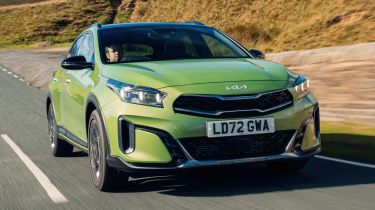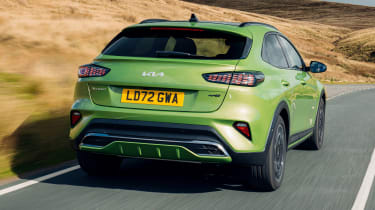New Kia XCeed 2022 review
A number of subtle enhancements are intended to keep the top-selling XCeed in fighting form against its crossover rivals, but it’s beginning to show its age

Verdict
The XCeed is a firm favourite with Kia customers, and there’s nothing included in this facelift that’s likely to put them off. Improving on such a successful formula has only warranted a light sprinkling of changes, but they haven’t quite managed to stop the XCeed looking a teeny bit dated next to some of the more recent arrivals in what has become very a crowded market.
The XCeed is an important car for Kia. It only accounts for 10 per cent of the brand’s UK sales, but if the results of our Driver Power new-car survey are anything to go by – it topped the 2022 satisfaction poll – then owners are clearly over the moon with it as an ownership proposition.
With a steady flow of new Kia models being released this year, such as the latest Niro and Sportage, the XCeed has received a dose of updates to keep it up to scratch with the rest of the range.
As part of the facelift, the XCeed’s line-up has been simplified; buyers now have the option of 2, 3, GT-Line and GT-Line S trims. The engine options have been slimmed down, too. UK buyers must choose between a 1.5 T-GDi petrol or a 1.6-litre plug-in hybrid – both of which have been carried over from the pre-facelift car. Kia believes the petrol engine will be the most popular, so that’s the car we’re focusing on here.
Used - available now

2022 KIA
Xceed
10,882 milesManualPetrol1.5L
Cash £17,000
2021 KIA
Xceed
18,387 milesAutomaticPetrol1.6L
Cash £17,600
2024 KIA
Xceed
17,108 milesManualPetrol1.5L
Cash £18,700
2022 KIA
Xceed
27,204 milesManualPetrol1.0L
Cash £12,700With 158bhp and 253Nm of torque, the petrol-powered XCeed’s performance is reasonable but not particularly exciting, with 0-60mph taking 8.7 seconds. The turbocharged four-cylinder engine is quite eager to rev, and there’s an adequate amount of power for easy overtaking. The engine is seemingly dependent on this boost, though, because quite a lot of revs are needed to move away from a standstill. This results in a loud growl from the engine, which some may find intrusive.
As with the previous model, rubber bump-stop floats in hydraulic fluid are placed within the front shock absorbers to help keep things comfortable, along with a dynamic damper at the rear crossmember. The springs have also been softened compared with the regular Ceed, and the result is a respectably settled ride for a car of this class. Smaller bumps can still cause some disruption at lower speeds, though.
Turn a corner and it becomes evident that this emphasis on comfort hasn’t come at a great cost in terms of handling, because the XCeed maintains its composure well, as long as you’re sticking to sensible speeds.
On the outside the tweaks are mostly pretty subtle at first glance. One of the more noticeable changes is that the front foglights have been relocated into the headlight clusters, making way for a pair of air curtains, which are designed to guide air around the wheels. These have been added in order to reduce drag and improve fuel economy.
Other changes to the XCeed include a revised grille and front bumper, upgraded LED lights and a new diffuser. The petrol-powered 3 and all GT-Line and GT-Line S models also get 18-inch alloys as standard.
The interior of the XCeed is similar to that of the pre-facelift model, but some minor improvements have been made. A 10.25-inch touchscreen infotainment system is now fitted to all models except the base 2 trim, and this features Apple CarPlay and Android Auto, Kia Connect, and Kia Live, the latter providing information such as fuel prices and even football scores. The XCeed’s infotainment system isn’t the slickest on the market, but it is straightforward to operate. The physical climate controls have also been kept.
In light of these upgrades, however, it’s difficult to overlook the fact that the XCeed’s interior feels a little dated when compared with the Niro or Sportage. The GT-Line S does get a 12.3-inch digital instrument cluster which feels more modern, but all other models continue to use analogue dials.
The XCeed’s crossover styling means headroom is a little compromised for taller passengers in the back, but there’s lots of legroom. Large C-pillars also mean that rear blindspots impede otherwise-good all-round visibility. Boot capacity is 426 litres, rising to 1,378 litres with the rear seats folded.
Prices starts from £23,345 for the base 2 trim. For an extra £1,500 you can move up to the 3, which adds the 10.25-inch touchscreen, rain-sensing wipers, heated front seats and steering wheel, an electronic parking brake and 18-inch alloys.
The GT-Line S that we tested costs £30,345, which may seem steep for a smaller Kia, but this is slightly less than a number of similarly specced rivals such as the Toyota C-HR. As always, every XCeed includes Kia’s renowned seven-year/100,000-mile warranty as standard.
| Model: | Kia XCeed 1.5 T-GDi GT-Line S |
| Price: | £30,345 |
| Engine: | 1.5 litre 4-cylinder turbocharged petrol |
| Power/torque: | 158bhp/253Nm |
| Transmission: | Six-speed manual, front-wheel drive |
| 0-60mph: | 8.7 seconds |
| Top speed: | 129mph |
| Economy/CO2: | 44.8mpg/143g/km |
| On sale: | Now |
Looking to sell your current car quickly and for a good price? Try our Free Car Valuation tool today!










